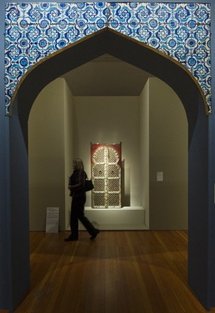
The works on display in Berlin's Martin-Gropius-Bau until June 6 are from the collection of Karim Aga Khan IV, the spiritual head of the Ismaili Muslims who is regarded as a direct descendent of the Prophet Mohammed.
The entire collection is due to be housed from 2013 onwards in the new Aga Khan Museum in Toronto, Canada, in a new building designed by Japanese architect Fumihiko Maki.
Items from the Aga Khan Museum's collection have been shown in London, Paris, Lisbon and Madrid, but the Berlin show will be the largest exhibition to date, organisers said.
Highlights in Berlin include pages from the Persian heroic epic "Shahnama" ("Book of Kings") by the poet Firdawsi, a Mongolian robe of silk damask from the 13th century and a double page of the "Blue Koran" from the ninth century.
Also on show is the oldest known Arabic manuscript of the "Canon of Medicine" by philosopher and physician Ibn Sina, which served as a standard work and textbook for physicians in Europe for over 500 years.
One section in the exhibition, "The Word of God", includes Koran manuscripts and objects dealing with the pilgrimage to Mecca or Islamic mysticism.
"The Route of the Travellers" meanwhile takes the visitor on a journey through the Islamic world, from Al-Andalus, the Muslim part of the Iberian Peninsula, through the Maghreb and Sicily, Egypt, Constantinople, Damascus, Baghdad and on to Persia, Central Asia and the Moghul Empire in India.
German President Horst Koehler, at the gala opening of the exhibition late on Tuesday, said he hoped the artworks on display would be a "contribution to a dialogue between cultures."
----------------------------------------------------------------------
The entire collection is due to be housed from 2013 onwards in the new Aga Khan Museum in Toronto, Canada, in a new building designed by Japanese architect Fumihiko Maki.
Items from the Aga Khan Museum's collection have been shown in London, Paris, Lisbon and Madrid, but the Berlin show will be the largest exhibition to date, organisers said.
Highlights in Berlin include pages from the Persian heroic epic "Shahnama" ("Book of Kings") by the poet Firdawsi, a Mongolian robe of silk damask from the 13th century and a double page of the "Blue Koran" from the ninth century.
Also on show is the oldest known Arabic manuscript of the "Canon of Medicine" by philosopher and physician Ibn Sina, which served as a standard work and textbook for physicians in Europe for over 500 years.
One section in the exhibition, "The Word of God", includes Koran manuscripts and objects dealing with the pilgrimage to Mecca or Islamic mysticism.
"The Route of the Travellers" meanwhile takes the visitor on a journey through the Islamic world, from Al-Andalus, the Muslim part of the Iberian Peninsula, through the Maghreb and Sicily, Egypt, Constantinople, Damascus, Baghdad and on to Persia, Central Asia and the Moghul Empire in India.
German President Horst Koehler, at the gala opening of the exhibition late on Tuesday, said he hoped the artworks on display would be a "contribution to a dialogue between cultures."
----------------------------------------------------------------------









 Home
Home Politics
Politics









